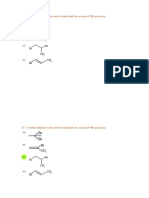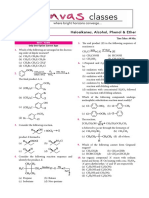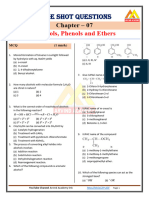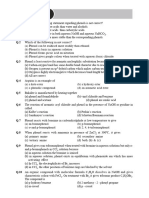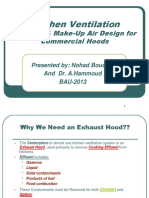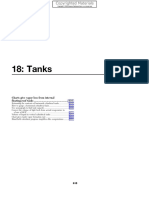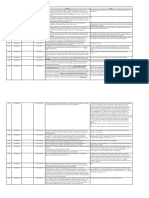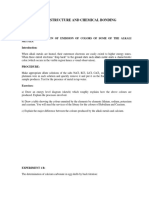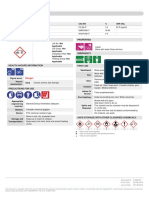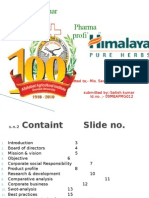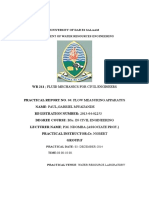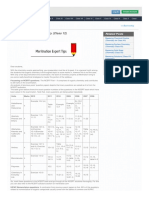Total Marks: 160 Time: 180 Minutes
Chemistry
Q.4 The steam volatile compounds among the following
are:
Q.1 Benzene is treated with oleum to produce compound
(X) which when further heated with molten sodium
hydroxide followed by acidification produces A.
compound (Y).The compound Y is treated with zinc
metal to produce compound (Z). Identify the
structure of compound (Z) from the following option. B.
A) B) C.
D.
C) D)
Choose the correct answer form the option given
Q.2 Which one of the following, with HBr will give a below:
phenol?
A) A and B only
A) B) A, B and C only
C) and D only
D) A and C only
B)
Q.5 Major product formed in the following reaction is a
mixture of:
C)
D)
Q.3 A) and (CH3) 3COH
B)
A)
C) and (CH3) 3COH
B)
D) and (CH3) 3Cl
C)
D) Q.6 Decreasing order of dehydration of the following
alcohols is
A) a >d >b > c B) d >b > c > a
C) b > a >d > c D) b >d > c > a
1/8
�Q.7 Match List-I with List-II. Q.10 Incorrect method of preparation for alcohols from
List-I Reactant List-II Product the following is:
(A) Phenol, Zn / ∆ (I) Salicylaldehyde A) Ozonolysis of alkene.
(B) Phenol, CHCl3, NaOH, HCl (II) Salicylic acid B) Hydroboration-oxidation of alkene.
C) Reaction of alkyl halide with aqueous NaOH.
(C) Phenol, CO2, NaOH, HCl (III) Benzene
D) Reaction of Ketone with RMgBr followed by
(D) Phenol, Conc. HNO3 (IV) Picric acid hydrolysis.
Choose the correct answer from the option given
below. Q.11 In the cumene to phenol preparation in presence of
air, the intermediate is
A) (A)-(III), (B)-(IV), (C)-(I), (D)-(II)
B) (A)-(III), (B)-(I), (C)-(II), (D)-(IV)
C) (A)-(IV), (B)-(I), (C)-(II), (D)-(III)
A) B)
D) (A)-(IV), (B)-(II), (C)-(I), (D)-(III)
Q.8 The major product(P) in the following reaction is
C) D)
Q.12 In a reaction,
A)
reagents ‘X’ and ‘Y’ respectively are:
B) A) CH3OH / H+ , Δ and CH3OH / H+ , Δ
B) (CH3CO) O / H and CH OH / H+ , Δ
+
2 3
(CH3CO) 2O / H+ and
C)
(CH3O) O / H+
2
C) D) CH3OH / H+ , Δ and (CH3CO) 2O / H
+
Q.13 Identify A and B in the following reaction sequence.
Conc. HNO3 (i) NaOH
⎯⎯⎯⎯⎯⎯⎯⎯⎯⎯⎯A⎯⎯⎯⎯⎯⎯⎯⎯B
D) (ii) HCl
A)
Q.9 Which of the following compound will most easily be
attacked by an electrophile?
B)
A) B)
C)
C) D)
D)
2/8
�Q.14 Match List-I with List-II. Q.16 The major products formed:
List-I (Reaction) List-II (Reagent (s))
(A) (I) Na2Cr2O7, H2SO4
A and B respectively are:
(i) NaOH
(B) (II)
(ii) CH3Cl
A)
(i) NaOH, CHCl3
(C) (III) (ii) NaOH
(iii) HCl
(i) NaOH
(D) (IV) (ii) CO2
(iii) HCl B)
Choose the correct answer from the options given
below:
A) (A)-(IV); (B)-(I); (C)-(III); (D)-(II)
B) (A)-(IV); (B)-(III); (C)-(I); (D)-(II)
C) (A)-(II); (B)-(III); (C)-(I); (D)-(IV)
D) (A)-(II); (B)-(I); (C)-(III); (D)-(IV) C)
Q.15 The final product A, formed in the following reaction
sequence is
(i) BH3
(ii) H2O2, ⊝ OH
Ph − CH = CH2⎯⎯⎯⎯⎯⎯⎯⎯⎯⎯⎯⎯⎯⎯⎯⎯⎯⎯⎯⎯⎯⎯⎯⎯⎯⎯⎯⎯
(iii) HBr
A
(iv) Mg, ether, thenHCHO / H3O+
D)
A) Ph–CH2 –CH2 –CH3
B) Q.17 Identify A in the given reaction.
C) Ph–CH2 –CH2 –CH2 – OH
D)
A) B)
C) D)
3/8
�Q.18 Identify the major products A and B respectively in the following set of
reactions.
Q.21 Given below are two statements :
Statement (I) : p-nitrophenol is more acidic than m-
nitrophenol and o-nitrophenol.
Statement (II) : Ethanol will give immediate
turbidity with Lucas reagent.
In the light of the above statements, choose the
correct answer from the options given below.
A)
A) Statement I is false but Statement II is true
B) Statement I is true but Statement II is false
C) Both Statement I and Statement II are true
B) D) Both Statement I and Statement II are false
Q.22 Phenol treated with chloroform in presence of
sodium hydroxide, which further hydrolyzed in
C) presence of an acid results
A) Benzene-1, 3-diol
B) Salicylic acid
C) 2-Hydroxybenzaldehyde
D)
D) Benzene-1, 2-diol
Q.23 In the following reaction
Q.19 Given below are two statements : one is labelled as
Assertion A and the other is labelled as Reason R.
Assertion A : Aryl halides cannot be prepared by
replacement of hydroxyl group of phenol by halogen
atom. A)
Reason R : Phenols react with halogen acids
violently.
In the light of the above statements, choose the
most appropriate from the options given below. B)
A) A is false but R is true
B) Both A and R are true but R is NOT the correct
explanation of A C)
C) A is true but R is false
D) Both A and R are true and R is the correct
explanation of A D)
Q.20 Reaction of Grignard reagent, C2H5MgBr with C8H8O
followed by hydrolysis gives compound "A" which Q.24 A compound 'X' is acidic and it is soluble in NaOH
reacts instantly with Lucas reagent to give solution, but insoluble in NaHCO3 solution.
compound B, C10H13Cl. The Compound "B" is Compound 'X' also gives violet colour with neutral
FeCI3 solution. The compound 'X' is
A) B)
A) B)
C) D)
C) D)
4/8
�Q.25 In Reimer - Tiemann reaction, phenol is converted Q.28 Which one of the following reactions is NOT
into salicylaldehyde through an intermediate. The possible?
structure of intermediate is ______.
A)
A)
B)
B)
C)
C)
D)
D)
Q.26 Given below are two statements. One is labeled as Q.29 In the reaction given below
Assertion (A) and the other is labeled as Reason (R).
Assertion (A): Butan-1-ol has higher boiling point
than ethoxyethane.
Reason (R): Extensive hydrogen bonding leads to
stronger association of molecules.
In the light of the above statements, choose the ‘B’ is
correct answer from the options given below.
A) A is false but R is true
A)
B) Both A and R are true and R is the correct
explanation of A
C) A is true but R is false
D) Both A and R are true but R is not the correct
explanation of A B)
Q.27 Given below are two statements: One is labelled as
Assertion A and the other is labelled as
Reason R. C)
Assertion A: Alcohols react both as nucleophiles
and electrophiles.
Reason R: Alcohol is react with active metals such
as sodium, potassium and aluminium to yield
corresponding alkoxides and liberate hydrogen. D)
In the light of the above statements, choose the
correct answer from the options given below.
A) Both A and R are true but R is NOT the correct
explanation of A
B) A is true but R is false
C) Both A and R are true and R is the correct
explanation of A
D) A is false but R is true
5/8
�Q.30 The major product formed in the following reaction is: Q.33 Match List-I with List-II.
A) B)
C) D)
Q.31 Given below are two statements.
Statement I: Picric acid is 2, 4, 6-trinitrotoluene.
Statement II: Phenol-2, 4-disulphuric acid is treated
with conc. HNO3 to get picric acid.
In the light of the above statements, choose the most
appropriate answer from the options given below.
A) Statement I is incorrect but Statement II is
correct.
B) Both Statement I and Statement II are incorrect.
C) Statement I is correct but Statement II is
incorrect.
D) Both Statement I and Statement II are correct.
Q.32 An organic compound ‘ A ’ with empirical formula Choose the correct answer from the options given
C6H6O gives sooty flame on burning. Its reaction with
below :
bromine solution in low polarity solvent results in
high yield of B . B is A) (A)-(III), (B)-(II), (C)-(I), (D)-(IV)
B) (A)-(IV), (B)-(II), (C)-(III), (D)-(I)
C) (A)-(I), (B)-(IV), (C)-(II), (D)-(III)
A) D) (A)-(II), (B)-(IV), (C)-(I), (D)-(III)
Q.34 Which one the following compounds will readily
B) react with dilute NaOH?
A) C 6H5CH2OH B) C 2H5OH
C) (CH3) 3COH D) C 6H5OH
C)
D)
6/8
�Q.35 Identify the products [A] and [B], respectively in the Q.38
following reaction:
A)
A)
B)
B)
C)
C)
D)
D)
Q.36 Given below are two statements :
Statements (I) : The boiling points of alcohols and
phenols increase with increases in the number of C-
atoms.
Statements (II) : The boiling points of alcohols and Q.39
phenols are higher in comparison to other class of
compounds such as ethers, haloalkanes.
In the light of the above statements, choose the
correct answer the options given below :
A) Statement I is false but Statement II is true
B) Statement I is true but Statement II is false
C) Both Statement I and Statement II are true
D) Both Statement I and Statement II are false A)
Q.37 What amount of bromine will be required to convert
2g of phenol into 2,4,6-tribromophenol?
(Given molar mass in g mol−1 of C, H, O, Br are 12, 1, B)
16, 80 respectively)
A) 6.0 g B) 20.44g
C) 10.22g D) 4.0g
C)
D)
7/8
�Q.40 For the compounds :
(A)
(B)
(C)
(D)
The increasing order of boiling point is :
Choose the correct answer from the options given
below :
A) (A) < (B) < (C) < (D)
B) (B) < (A) < (C) < (D)
C) (D) < (C) < (A) < (B)
D) (B) < (A) < (D) < (C)
8/8
� ANSWER KEY
Chemistry
1. B 2. A 3. C 4. A 5. B 6. D
7. B 8. D 9. D 10. A 11. D 12. B
13. A 14. B 15. C 16. B 17. B 18. A
19. C 20. C 21. B 22. C 23. D 24. B
25. D 26. B 27. A 28. B 29. D 30. C
31. A 32. C 33. D 34. D 35. A 36. C
37. C 38. B 39. A 40. B
1/1

